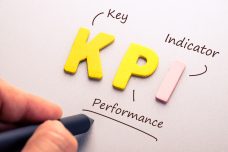You are an expert in your field. You have the technical skills and experience. You meet your manager in the hallway. Your manager asks you where you are at with your recent assignment. He/ she asks you to do 1 to 2 page, 10-mins presentation in the afternoon?
This may or may not be a specific project, but might be an assignment your boss has asked you to work on recently.

The assignment is not going very well, but you have done a lot of work on it. There are so many things you want to communicate in that 10-mins presentation. Your mind swells. You started working on the 1-2 page slide…. You cut and paste the list of things you are working on. By the time you are done… it is already 10 pages. You review each page; you reduce the font size to 8 pts or below to fit it. You look at it again, you could not even read it.
What to do?
I am sure we have all run into that situation no matter what level you are at in your organization. You may or may not be a project manager, but the key point is your stakeholder asked you for a very short presentation on the progress of your assignment. You have to be precise and to the point. Your manager may or may not be as technically strong as you, but you need to bring the 10000 ft below information up to the 10000 ft or above level.
This is a soft skill, presentation skill you must master in the workplace. Being a program/ project manager for over 15+ years, there are 4 strategies I have put together to help you get there:
- Strategy #1 – Need to know vs want to know
- Strategy #2 – A framework of presentation
- Strategy #3 – The benefit you are trying to achieve and when organization can see the benefit (OKR)
- Strategy #4 – What is the help you need?
Strategy #1 – Need to know vs want to know
Need to know – this is exactly what your manager asked you in the hallway “Where are you at with your assignment?”. This is a combo questions:
- What have you done so far?
- When you are going to be done?
This means, you need to communicate:
- Your accomplishments
- What’s next? And a date when are you going to be done

Want to know – this is the part that will get you into trouble. This is all your technical detail. It is optional, i.e. not necessary for you to communicate. You only communicate when asked, not volunteered. Remember, you have 10-mins. If you volunteer a lot of detail, it will derail your presentation and your stakeholders will take you to a completed different direction. Control yourself
“Hold it… hold it… give me more detail?” Then you know you did not communicate your message well.
Tip: Finish the main points and only volunteer info when asked in Q&A.
Strategy #2 – Use a framework of presentation
Due to the 10-minute time-limit, your info communicated must be precise, direct and to the point, no fluff. To assist this, a slide framework is highly recommended.
Slide 1 – Frame the assigned asked. Give a refresh of the ask.
- The assignment (or project) – 1-2 sentence frame it and describe the benefit. Discuss further in pt.3
- List what is in scope – What is in scope you are working on.
- List what is out-of-scope – clarify what you are NOT working on. This is a life-saver section because it sets expectation what you are NOT working on.
Slide #2 – Framework to answer “Where are you at with your assignment?”
- Color Status – Give a Status GREEN/ YELLOW/ RED. You could break this down further to Scope, budget, schedule and overall
- Overall status – 1-2 sentence where you are at.
- Accomplishments – what you have done so far in point form. In this point form describe what was completed in 1 sentence, 10 words or less. 3 – 5 points. Do no elaborate.
- What’s next – in point form “action items” to get to the finish line or next milestone
- Hot items (optional) – I like to put a hot items section to indicate out of the work coming up, what is HOT and might need support on
- Business related Milestone (or major milestones) – if it is a small assignment, there might be just one milestone to the finish. If it is a more complex assignment, list out the steps/ milestones upcoming. Only speak to the final delivery date or the final milestone. Be silent on the other milestones. Reminder, you have 10 minutes. Talk only when asked.
- Risks/ issues – list out in point form the Risk you are facing and the response plan. For an Issue describe the issue and describe the action plan to resolve it. In listing the risks/ issues, you MUST think through what is relevant to the audience. Do they need to know and what can they do about it. This relevance has 2 understandings:
- What is blocking your manager from receiving the benefits?
- How can the manager help you to resolve them?
Anything more than these 2 understandings, do NOT put it on the slide. Talk to it if asked.
Strategy #3 – Communiate the benefit and when your manager or the organization can receive it (OKR)
- The outcome – Describe the benefit or business value your manager or organization will receive from you completing the assignment.
- Not the output – e.g. create a final report. Report is the output. Outcome is the information or insight delivered from that report. An example will be, a “Output” report that discovered customers drop off 20% of the time when completing an online purchase order. An “outcome” report will be, upon further investigation, customers are dropping only when purchasing a specific category of products. It was discovered that the shipping option disappears from the online form when that specific category of product is selected. The customer cannot select a shipping option and complete the order.
Strategy #4 – What is the help you need?
If your manager is asking where you are at with your assignment, he/ she obviously cares about the assignment. Use this opportunity to make your pitch. In the Risk/ Issue section, request assistance.
This tip will often help you stop a lot of further questions, because you redirected the stakeholder’s attention to self-reflect. What can they do to help, rather than drilling down unnecessarily.

In conclusion:
- Improve your presentation skills: Concise and to the point message.
- Figure out who is the target audience?
- Keep the presentation on NEED to know, NOT want to know basis.
- Never volunteer too much detail on the slide. Talk to it when asked.
- Use a framework to help you move through the presentation
- Communicate the benefit or business value. Use the OKR framework.
I have put together 2-page deck template I have refined over the years that have saved me from many situations. If you are interested, you can comment me.
Have a good presentation.
To manage your corporate-wide OKRs better, click the “sign up” button at the top right of this page to get a free trial of our Target Align OKR cloud app.
Follow us on:
 Go back to blogs
Go back to blogs 

